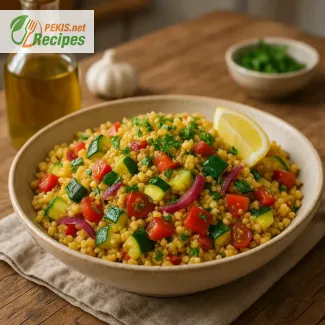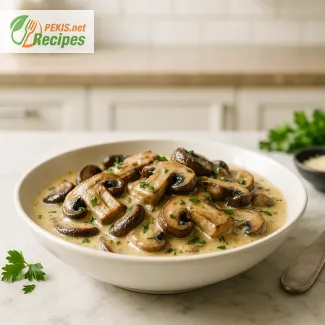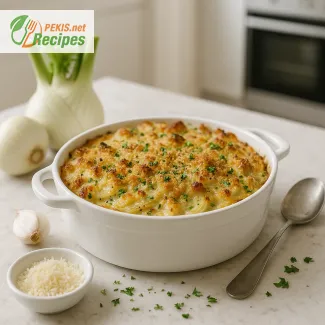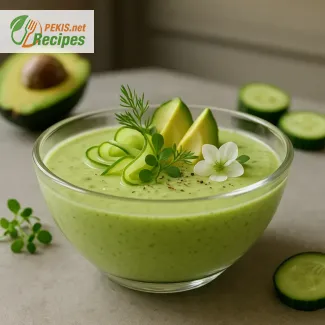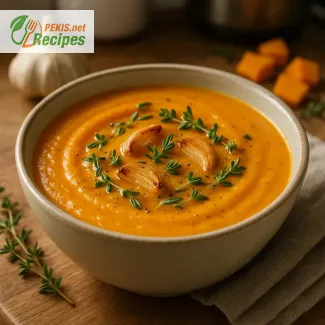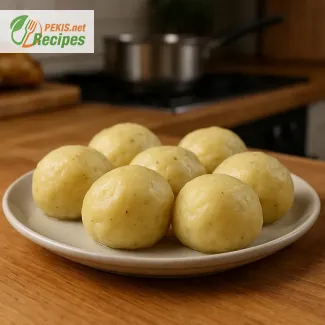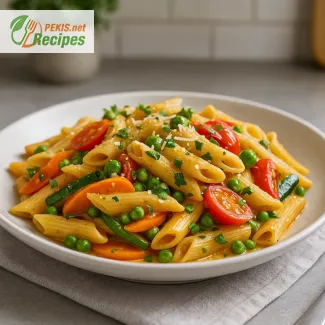
Fresh veggie pasta in a single pot – colorful, creamy and quick
Why this spring-inspired dish deserves a place in your weekly dinner rotation
One‑Pot Pasta Primavera is more than just a quick weekday meal—it’s a celebration of seasonal vegetables, vibrant colors, and balanced flavor, all brought together in under 30 minutes. This easy vegetarian dinner combines the brightness of fresh vegetables with the comfort of creamy pasta in a way that feels indulgent yet wholesome. Unlike heavy sauces or overly complicated dishes, this one-pot version keeps cleanup minimal and satisfaction high, making it the perfect dinner solution for busy home cooks who don’t want to compromise on flavor or nutrition.
The appeal of one-pot pasta dishes
With more people looking for fast and healthy meals, one-pot recipes have become kitchen essentials. Pasta primavera is especially loved because it offers the flexibility to incorporate a wide range of vegetables—whether it’s zucchini, bell peppers, cherry tomatoes, peas, or carrots—without requiring separate cooking steps. Everything simmers together in one pot, letting the flavors mingle and the pasta absorb the natural sweetness of the vegetables. For families, students, or anyone who needs a nutritious meal with minimal effort, this recipe hits all the marks.
What makes Pasta Primavera special?
At its core, pasta primavera is about letting seasonal produce shine. Unlike classic tomato or pesto sauces, this dish often uses a light cream sauce or olive oil base, which enhances the vegetables without overpowering them. The resulting flavor is fresh, slightly tangy, and deeply satisfying. It's the kind of meal that feels light but still comforting, perfect for warmer days when heavier sauces might feel too rich.
Additionally, the flexibility of the recipe makes it highly adaptable. From choosing your favorite pasta shape (penne, fusilli, or spaghetti all work beautifully) to adjusting the vegetable mix based on what’s in season, there’s room to make this recipe your own. You can even add grated Parmesan or a splash of lemon juice to brighten the whole dish.
Who will love this recipe?
This dish is ideal for:
- Home cooks searching for quick vegetarian dinner recipes.
- Parents who want a veggie-packed meal the kids will actually eat.
- Meal preppers who enjoy dishes that reheat well.
- Pasta lovers looking to lighten up traditional pasta dishes.
It’s not just a time-saver—it’s a dinner that pleases a crowd and makes vegetables exciting, even for picky eaters.
Perfect for seasonal transitions
One‑Pot Pasta Primavera really shines in spring and early summer, when fresh vegetables are at their peak. Asparagus, snap peas, and baby carrots are excellent seasonal additions. But its adaptability also means you can enjoy it year-round—just swap in broccoli, spinach, mushrooms, or even frozen veggies when fresh options are limited. This ability to change with the seasons makes it a versatile dinner staple for any home kitchen.
Creamy or light? Choose your sauce style
One of the joys of pasta primavera is that it works just as well with a creamy sauce as it does with a light olive oil base. A splash of cream or a spoonful of ricotta or mascarpone can transform the dish into something rich and cozy, perfect for cool evenings. On the other hand, tossing the veggies and pasta in extra virgin olive oil, garlic, and herbs creates a clean, Mediterranean-style plate that feels perfect for a summer night.
You can also try using plant-based alternatives like cashew cream or oat cream for a vegan twist. The end result remains just as flavorful and comforting, while accommodating different dietary needs.
Tips for success in every bite
- Cut vegetables evenly so they cook at the same pace.
- Sauté the aromatics—like garlic and onion—first to build a flavor base.
- Add more delicate vegetables (like spinach or peas) towards the end so they don’t overcook.
- Use vegetable broth instead of water to deepen the flavor of the pasta.
- Finish with a generous amount of fresh herbs, such as basil or parsley, for a fragrant touch.
These small details take a simple dish from good to unforgettable.
One-pot efficiency without sacrificing flavor
Unlike traditional pasta recipes that involve multiple pans and timing challenges, this version is both efficient and delicious. Cooking everything in one pot not only cuts down on dishes, but also means the pasta is cooked directly in the flavorful base, absorbing the essence of the vegetables, herbs, and broth. This results in a more integrated and intense flavor profile without added complexity.
Make it your own with seasonal or pantry swaps
The real strength of this recipe lies in its customizability. Got leftover roasted veggies in the fridge? Toss them in. Want a protein boost? Add some chickpeas, white beans, or even a poached egg on top. Prefer a little spice? Sprinkle in red pepper flakes or a dash of chili oil.
Even if your fridge is looking sparse, you can rely on frozen vegetables and dry pantry ingredients to bring this meal together. That’s what makes it such a reliable go-to for busy evenings.
When simplicity meets satisfaction
Pasta Primavera has a certain elegance in its simplicity. It’s not fussy, doesn’t require obscure ingredients, and yet it delivers a complete meal that feels nourishing and flavorful. Whether you're new to cooking or a seasoned home chef, the one-pot method is approachable and rewarding.
This dish proves that vegetarian meals can be just as hearty and indulgent as any meat-based recipe. It’s proof that when you treat vegetables with care, they can be the star of the plate.
- Heat the oil in a large deep sauté pan or pot over medium heat. Add chopped onion and cook for 2–3 minutes until soft and translucent.
- Add garlic, carrot, and bell pepper, and sauté for 4–5 minutes until slightly tender.
- Add zucchini, cherry tomatoes, and peas. Stir for 2 minutes to combine and begin softening the vegetables.
- Pour in the pasta and vegetable broth, stir gently to distribute evenly. Bring to a boil, then reduce to a simmer. Cover and cook for 10–12 minutes, stirring occasionally, until pasta is cooked and broth mostly absorbed.
- Stir in the cream and Parmesan cheese. Mix well and let simmer uncovered for 2–3 minutes until slightly thickened.
- Season with salt, black pepper, and lemon juice. Stir in chopped parsley and remove from heat.
- Let stand for 2 minutes, then serve warm with additional Parmesan if desired.
Elevate your Pasta Primavera: Creative twists and kitchen-tested improvements
Smart upgrades for a brighter, bolder and more satisfying one-pot veggie pasta
When a dish like One‑Pot Pasta Primavera already hits all the right notes—simple, colorful, and full of fresh vegetables—it might seem like there’s little left to improve. But even the most beloved recipes can be elevated with thoughtful tweaks. By experimenting with the ingredients, cooking methods, and seasonings, you can bring deeper flavor, better texture, and more nutrition to the table. Whether you're a home cook looking to fine-tune the dish or a beginner hoping to avoid common mistakes, understanding what works and why will help you get the best result, every time.
Add depth of flavor with aromatic layers
One common pitfall with quick veggie pasta dishes is that they can sometimes taste flat or underseasoned. To avoid this, consider upgrading your base layer of flavor. Instead of just sautéing onions and garlic, try adding a splash of white wine after the aromatics have softened. Let it simmer for a minute or two to allow the alcohol to evaporate—what remains is a subtle, complex acidity that enhances the brightness of the vegetables.
You can also include a bay leaf or a pinch of thyme during the simmering stage for more aromatic depth. Fresh herbs added at the end brighten the flavor, but a small amount of dried herbs cooked early adds richness and savory background notes.
Creamier texture without heavy cream
While heavy cream gives the dish its signature smoothness, it’s not the only route to a velvety finish. If you want to make it lighter without sacrificing texture, try using:
- Mascarpone or ricotta for a milder, slightly sweet creaminess.
- Cashew cream for a dairy-free version that stays rich and full-bodied.
- Greek yogurt (added after removing from heat) to introduce tang and protein.
Blending a portion of the cooked vegetables with a bit of broth before adding them back in can also create a naturally creamy base, enhancing texture without adding extra fat.
Boost umami with small, intentional additions
For a deeper, more savory flavor profile, include a spoonful of miso paste, a splash of soy sauce, or even a few sun-dried tomatoes finely chopped into the mix. These umami boosters don't overwhelm the dish but elevate it to restaurant quality by deepening the base notes.
Even a touch of grated hard cheese like Pecorino Romano (in place of or alongside Parmesan) introduces a sharper, saltier contrast that plays beautifully with the sweetness of the vegetables.
Get better results with proper pasta handling
A common mistake when making one-pot pasta is overcooking the noodles. Since the pasta cooks directly in broth with vegetables, it's essential to monitor closely. Always stir occasionally to prevent sticking and test for doneness a minute or two before the package instructions suggest. The starch released by the pasta helps create the sauce, but if left too long, it can make the dish gummy.
To enhance flavor, toast the dry pasta briefly in olive oil before adding broth. This step gives it a slightly nutty aroma and helps prevent clumping.
Turn it into a protein-rich complete meal
While the dish is satisfying on its own, adding a lean protein source can turn it into a more balanced meal. Some excellent additions include:
- Grilled chicken breast, sliced and folded in at the end
- Chickpeas or white beans, simmered with the broth for added heartiness
- Tofu cubes, seared until golden and stirred in before serving
- A soft-poached egg placed on top just before plating for richness
Each option boosts the nutritional profile and creates new layers of texture and taste.
Healthier swaps that don’t compromise flavor
To make this dish more nutrient-dense while keeping it comforting, consider the following:
- Replace regular pasta with whole grain or legume-based pasta for extra fiber and protein.
- Use low-sodium vegetable broth to control salt levels without losing depth.
- Include dark leafy greens like spinach or kale toward the end of cooking to add antioxidants and minerals.
- Opt for nutritional yeast instead of cheese to provide a cheesy flavor that’s dairy-free and rich in B vitamins.
These substitutions maintain the dish’s appeal while increasing its overall health benefits.
What makes homemade Pasta Primavera better than takeout?
There’s no substitute for the freshness of a home-cooked meal. Most store-bought or takeout pasta dishes are loaded with excess salt, fat, and preservatives. Making it yourself ensures you’re using real vegetables, quality oils, and fresh herbs that offer both flavor and nutritional value.
Homemade also allows for full control of texture, from the al dente bite of the pasta to the perfect tenderness of each vegetable. Plus, it allows for easy adjustments based on personal preferences or dietary needs.
Avoid these common pitfalls
- Overcrowding the pot: Too many vegetables at once can lead to uneven cooking. Add in stages to keep textures distinct.
- Skipping the seasoning: Vegetables and pasta absorb salt differently. Season in layers—aromatics, broth, and final dish—to achieve balance.
- Using poor-quality broth: The broth forms the foundation of the sauce. Use a flavorful, preferably homemade or high-quality store-bought broth.
- Cooking delicate vegetables too early: Add peas, spinach, or herbs at the end to prevent mushiness and preserve color and nutrients.
Seasonal adaptations and flavor variations
In spring, asparagus, snap peas, and baby carrots make beautiful additions. In autumn, try adding roasted squash or mushrooms. A touch of chili flakes or lemon zest can liven up the flavor and make it more vibrant for warm weather, while toasted walnuts or pine nuts add texture and a hint of richness in cooler months.
By thoughtfully tweaking ingredients and understanding how each component affects the dish, you can turn this classic veggie pasta into a recipe that’s uniquely yours—balanced, bold, and better every time.
Allergens present in the recipe:
- Milk (heavy cream, Parmesan cheese)
- Gluten (pasta – typically made from wheat)
Suggestions to replace allergens and gluten:
- Use plant-based cream alternatives (e.g., oat cream, cashew cream) instead of heavy cream.
- Substitute Parmesan with nutritional yeast for a dairy-free option.
- Use gluten-free pasta (e.g., rice or lentil-based) to make the recipe suitable for gluten-intolerant individuals.
Vitamins and minerals per serving (approximate):
- Vitamin A: 680 µg – supports vision, immunity, and skin health.
- Vitamin C: 35 mg – boosts immune function and improves iron absorption.
- Vitamin K: 60 µg – important for blood clotting and bone metabolism.
- Folate (B9): 90 µg – essential for DNA synthesis and cell division.
- Potassium: 520 mg – helps regulate fluid balance and muscle contractions.
- Magnesium: 48 mg – supports muscle and nerve function, energy production.
- Calcium: 120 mg – maintains strong bones and teeth.
- Iron: 2.4 mg – necessary for oxygen transport in the blood.
Antioxidants per serving (approximate):
- Lycopene (from cherry tomatoes): 5 mg – protects cells from oxidative damage.
- Beta-carotene (from carrots): 4 mg – supports immune system and eye health.
- Lutein and zeaxanthin (from zucchini and peas): 2 mg – promote healthy vision.
